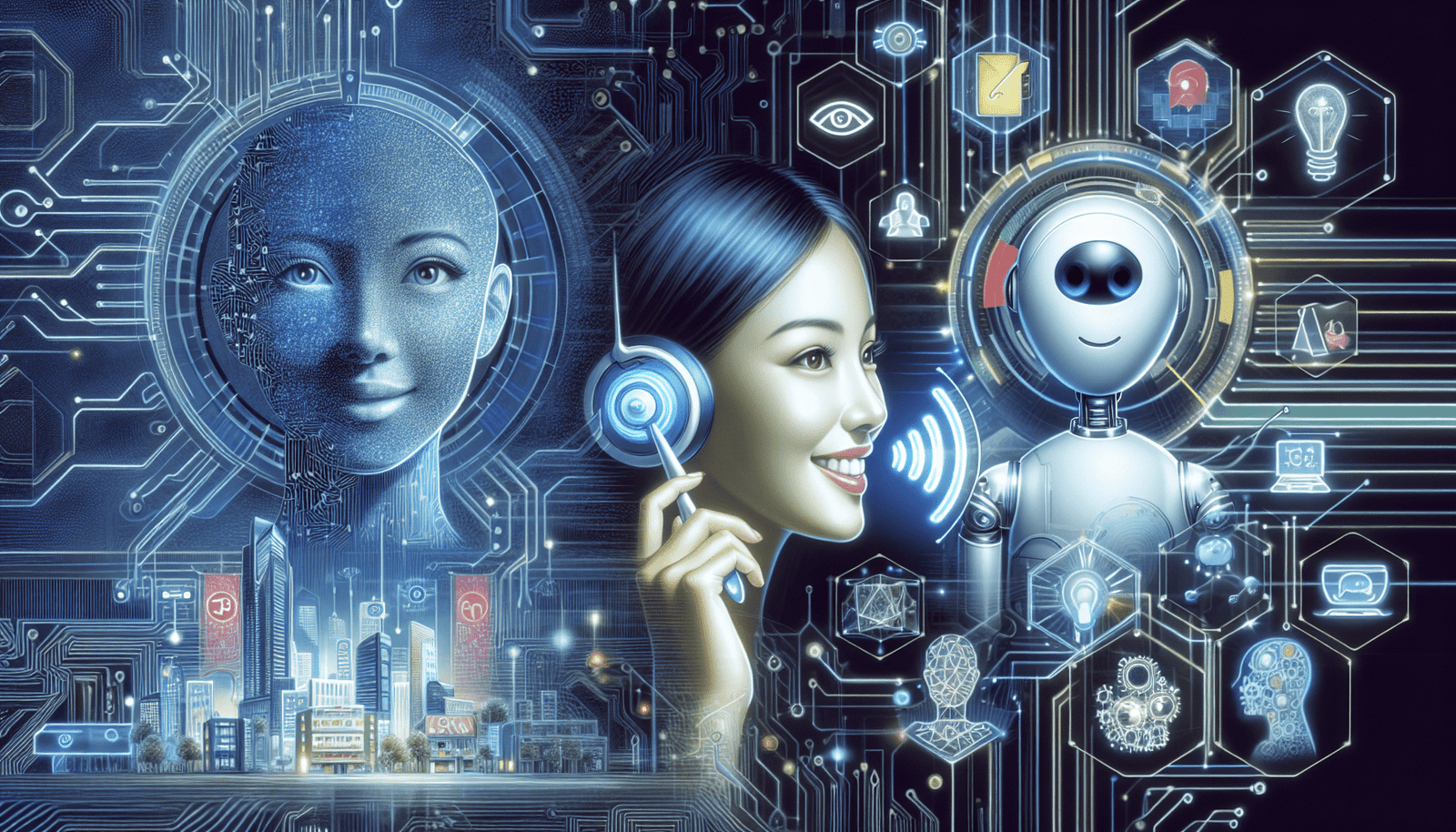Voice And Chatbot Integration
In the world of digital communication, the integration of voice and chatbot technology has revolutionized the way we interact with devices and platforms. This article explores the exciting advancements in this field and how it enhances the user experience. Discover the possibilities of seamlessly switching between voice commands and chatbot interactions, with tools like Jasper – the best writing assistant. Prepare to be amazed as this merging of technologies opens up a new realm of convenience and efficiency in our everyday lives.
What is Voice and Chatbot Integration?
Definition
Voice and chatbot integration refers to the combination of voice recognition technology and chatbot functionality to allow users to interact with an application or device using natural language commands. It enables seamless communication between users and chatbots, enhancing user experience and reducing the need for manual input.
Benefits
The integration of voice and chatbots offers numerous benefits. Firstly, it provides users with a more convenient and efficient way to interact with technology, as they can simply speak their commands instead of typing them out. This saves time and eliminates the potential for typing errors.
Additionally, voice and chatbot integration allows for a more natural and conversational user experience. Users can interact with chatbots using their own words and sentences, making the interaction feel more human-like. This creates a more engaging and personalized experience for users.
Furthermore, integrating voice and chatbots can lead to improved customer support and increased customer satisfaction. Chatbots can handle a wide range of customer queries and provide instant responses, allowing businesses to provide 24/7 support without the need for human intervention.
Overall, voice and chatbot integration enhances user experience, improves efficiency, and provides businesses with cost-effective customer support solutions.
How Does Voice and Chatbot Integration Work?
Voice Recognition Technology
Voice recognition technology is a key component of voice and chatbot integration. It enables devices and applications to convert spoken language into written text, which can then be processed by chatbot algorithms.
Voice recognition technology uses a combination of speech recognition algorithms and machine learning techniques to accurately transcribe spoken words. It analyzes patterns and characteristics in the voice input and matches them against a database of known words and phrases.
Natural Language Processing
Natural Language Processing (NLP) is another crucial element of voice and chatbot integration. NLP allows chatbots to understand and interpret human language in a way that is similar to how humans do.
NLP algorithms analyze the text generated by the voice recognition technology and extract meaning and context from it. This enables chatbots to understand user intent, identify key information, and generate appropriate responses.
NLP also enables chatbots to process complex language structures, including synonyms, idioms, and colloquialisms. This ensures that chatbots can understand and respond appropriately to a wide range of user inputs.
Chatbot Backend Integration
The backend integration of chatbots is the final piece of the voice and chatbot integration puzzle. Once the voice input has been transcribed and processed by the NLP algorithms, the chatbot backend takes over to generate a relevant and meaningful response.
The chatbot backend consists of a combination of predefined responses and dynamic algorithms. Predefined responses are designed to handle common queries and provide instant answers to frequently asked questions. Dynamic algorithms, on the other hand, analyze the user input, retrieve relevant information from databases or external APIs, and generate personalized responses.
The chatbot backend integration ensures that the chatbot can understand user queries, provide accurate and relevant responses, and continuously learn and improve its performance over time.
Use Cases of Voice and Chatbot Integration
Virtual Assistants
One of the most popular use cases for voice and chatbot integration is virtual assistants. Virtual assistants, such as Apple’s Siri or Amazon’s Alexa, use voice recognition technology and chatbot functionality to perform tasks and answer user queries.
Virtual assistants can help users with a wide range of tasks, including setting reminders, providing weather updates, answering general knowledge questions, and even controlling smart home devices. The integration of voice and chatbots makes virtual assistants more intuitive and user-friendly, allowing users to interact with them in a natural and conversational manner.
Customer Support
Voice and chatbot integration can revolutionize customer support services. Chatbots with voice recognition capabilities can handle customer queries and provide instant responses, reducing the need for human intervention.
Voice-enabled chatbots can provide 24/7 support, handling a high volume of customer queries simultaneously. They can provide accurate and consistent responses, ensuring a seamless customer experience. Customers can communicate with chatbots using their own words and sentences, making the interaction feel more personalized and human-like.
E-commerce
Voice and chatbot integration can also enhance the e-commerce experience for customers. Chatbots integrated with voice recognition technology can assist users in finding products, providing recommendations, and completing purchases.
Users can simply speak their preferences, and the chatbot will understand and generate relevant product suggestions. Voice-enabled chatbots can also process transactions, allowing users to make purchases without the need for manual input.
Healthcare
In the healthcare industry, voice and chatbot integration can improve patient engagement and provide remote support. Chatbots with voice recognition capabilities can assist patients in scheduling appointments, providing medication reminders, and answering general health-related questions.
Voice-enabled chatbots can also be integrated with medical devices and wearables, allowing them to collect and analyze health data. This data can then be used to provide personalized recommendations and interventions.
Smart Homes
Voice and chatbot integration has become a key feature in smart home systems. Chatbots integrated with voice recognition technology can control various aspects of a smart home, including lighting, temperature, security systems, and entertainment devices.
Users can simply speak their commands, and the chatbot will execute them accordingly. Voice-enabled chatbots can also learn user preferences and adjust settings automatically, providing a truly personalized smart home experience.
Education
Voice and chatbot integration has the potential to transform the education industry. Chatbots integrated with voice recognition technology can act as virtual tutors, assisting students with their learning journey.
Voice-enabled chatbots can answer student questions, provide explanations, and offer personalized learning recommendations. They can also assess student progress and provide feedback in real-time, enhancing the learning experience.
Challenges in Voice and Chatbot Integration
Accurate Speech Recognition
One of the main challenges in voice and chatbot integration is achieving accurate speech recognition. Voice recognition technology must be able to accurately transcribe spoken words and understand various accents, dialects, and languages.
Different speech patterns, background noises, and speaking speeds can also pose challenges to accurate speech recognition. Continuous advancements in speech recognition algorithms and machine learning techniques are necessary to overcome these challenges and improve accuracy.
Language Barriers
Another challenge in voice and chatbot integration is overcoming language barriers. Chatbots must be able to understand and respond to user queries in multiple languages seamlessly.
Translating spoken words into written text and then generating a response in the desired language requires robust natural language processing algorithms. These algorithms must be able to handle the complexities of different languages, including grammar rules, word order, and idiomatic expressions.
Privacy and Security
Privacy and security concerns are significant challenges in voice and chatbot integration. Voice-enabled chatbots interact with users in a highly personal and sensitive manner, requiring access to personal and sometimes confidential information.
Ensuring the privacy and security of user data is essential to build trust and confidence in voice-enabled chatbot systems. Secure data storage, encryption protocols, and user consent mechanisms are critical components in addressing these challenges.
Limited Context Understanding
Chatbots integrated with voice recognition technology often struggle with understanding the full context of a conversation. They may misinterpret user intents or fail to understand follow-up questions or references made earlier in the conversation.
Improving context understanding requires advancements in natural language processing algorithms, as well as the ability to analyze and retain conversation history. Continuous learning and adaptation are crucial to overcome this challenge and provide more accurate and context-aware responses.
Best Practices for Voice and Chatbot Integration
Seamless Conversational Experience
To provide a seamless conversational experience, voice and chatbot integration should prioritize natural and human-like interaction. Chatbots should be trained to understand and respond to user queries in a conversational manner, using natural language processing algorithms that capture the nuances of human conversation.
The integration should also aim to reduce latency and response times to ensure a smooth and real-time conversation. Users should feel like they are interacting with a helpful and responsive human assistant, rather than a machine.
Optimized Voice Recognition
To improve the accuracy and reliability of voice recognition, it is essential to utilize state-of-the-art speech recognition algorithms and models. These algorithms should be continuously trained and updated with a diverse dataset to ensure robustness across different languages, accents, and speech patterns.
User feedback and error analysis should be used to fine-tune the voice recognition system and address any recurring issues. Regular testing and evaluation should be conducted to measure the performance of the voice recognition technology and identify areas for improvement.
Personalization
Personalization plays a crucial role in enhancing user experience in voice and chatbot integration. Chatbots should be able to learn and adapt to user preferences over time, delivering more tailored and relevant responses.
By understanding user behavior, chatbots can offer personalized recommendations, anticipate user needs, and provide a more efficient and personalized service. User feedback and explicit or implicit preferences should be used to personalize the chatbot’s responses and interactions.
Multi-platform Support
To cater to a diverse user base, voice and chatbot integration should support multiple platforms and devices. Whether it is smartphones, smart speakers, or wearable devices, chatbots should be accessible and usable across a range of devices and operating systems.
This multi-platform support requires careful consideration of device-specific features and constraints. The chatbot interface should be optimized for different screen sizes, input methods, and device capabilities to ensure a consistent and intuitive user experience across platforms.
Future Trends in Voice and Chatbot Integration
Enhanced Natural Language Processing
The future of voice and chatbot integration lies in advancing natural language processing capabilities. Chatbots will become more sophisticated in understanding complex language structures, recognizing and responding to emotions, and capturing subtle linguistic nuances.
Advanced NLP algorithms will enable chatbots to engage in more natural and meaningful conversations with users, making the interaction feel even more human-like. This will result in enhanced user satisfaction and improved overall user experience.
Emotion Recognition
Integrating emotion recognition technology with voice and chatbot integration opens up exciting possibilities for personalized experiences. Chatbots will be able to detect and analyze user emotions through voice tone, speech patterns, and facial expressions.
With emotion recognition capabilities, chatbots can tailor their responses and interactions based on the user’s emotional state. This can lead to more empathetic and supportive interactions, especially in fields such as mental health support, customer service, and education.
Integration with IoT Devices
The integration of voice and chatbots with Internet of Things (IoT) devices will become increasingly prevalent in the future. Chatbots will be able to control and interact with a wide range of IoT devices, creating a seamless and interconnected smart environment.
Users will be able to give voice commands to chatbots to control their IoT devices, such as turning on lights, adjusting thermostats, or locking doors. This integration will enhance the overall user experience and create a more efficient and convenient smart home or workplace environment.
Voice Commerce
Voice commerce, also known as v-commerce, is emerging as a significant trend in voice and chatbot integration. Chatbots integrated with voice recognition technology will enable users to make purchases using voice commands.
Users will be able to browse products, add items to the cart, and complete the purchasing process purely through voice interaction. This simplifies the online shopping experience and provides a seamless and hands-free way of making purchases.
Voice and Chatbot Integration Tools and Platforms
Amazon Alexa
Amazon Alexa is a popular voice and chatbot integration platform. It provides developers with a suite of tools and resources to build voice-enabled chatbots for various applications and devices. Alexa offers a wide range of skills and integrations, making it a versatile platform for voice and chatbot integration.
Google Assistant
Google Assistant is another leading voice and chatbot integration platform. It enables developers to build chatbots that can be integrated with Google’s ecosystem of devices and services. Google Assistant offers advanced natural language processing capabilities and a wide range of APIs for seamless integration.
IBM Watson
IBM Watson is a powerful AI platform that includes voice and chatbot integration capabilities. It offers a suite of tools and services for building chatbots with advanced natural language processing and speech recognition capabilities. Watson provides developers with the flexibility and scalability to build voice-enabled chatbots for various industries and use cases.
Microsoft Azure Bot Service
Microsoft Azure Bot Service is a comprehensive platform for building, testing, and deploying chatbots. It supports voice and chatbot integration through its Speech Services and Cognitive Services, enabling developers to create voice-enabled chatbots with ease. Azure Bot Service also offers integration with Microsoft’s ecosystem of devices and services.
Dialogflow
Dialogflow, formerly known as API.AI, is a popular chatbot development platform that supports voice and chatbot integration. It provides developers with powerful natural language processing capabilities and pre-built integrations with major voice platforms such as Amazon Alexa and Google Assistant. Dialogflow offers a user-friendly interface and extensive documentation for building voice-enabled chatbots.
Successful Examples of Voice and Chatbot Integration
Apple Siri
Apple Siri is one of the most successful examples of voice and chatbot integration. Siri has become an integral part of Apple’s ecosystem, allowing users to interact with their devices using natural language commands. Siri can perform a wide range of tasks, including answering questions, providing recommendations, and controlling device settings.
Amazon Echo with Alexa
Amazon Echo, along with the voice assistant Alexa, has revolutionized voice and chatbot integration in the smart home industry. Users can interact with Alexa using voice commands to control various smart home devices, play music, search the internet, and much more. Alexa’s capabilities continue to expand through integration with third-party services and devices.
Google Home with Google Assistant
Google Home and its voice assistant, Google Assistant, provide seamless voice and chatbot integration for users. Google Assistant can perform tasks such as answering questions, providing directions, controlling smart devices, and even making restaurant reservations. Google’s ecosystem allows users to access their personalized information and preferences across multiple devices.
Future Implications of Voice and Chatbot Integration
Reduced Human Involvement
Voice and chatbot integration can lead to a significant reduction in human involvement in various industries. Chatbots with voice recognition capabilities can handle a wide range of tasks without the need for human intervention.
This can result in increased efficiency, cost savings, and improved scalability. Companies can deploy chatbots to handle customer support, sales inquiries, data analysis, and other repetitive and time-consuming tasks, freeing up human resources for more complex and strategic activities.
Transformation of User Interaction
Voice and chatbot integration are transforming the way users interact with technology. Instead of relying on typing or clicking, users can communicate with chatbots using their own words and sentences, making the interaction feel more natural and conversational.
This transformation in user interaction creates a more intuitive and personalized experience. Users can interact with technology in the same way they would with another person, reducing the learning curve and improving user adoption and satisfaction.
Innovative Business Opportunities
Voice and chatbot integration are opening up innovative business opportunities across various industries. Companies can leverage chatbots to provide 24/7 customer support, personalized recommendations, and targeted marketing campaigns.
Additionally, the integration of voice and chatbots with IoT devices enables businesses to create seamless and connected smart environments. This opens up possibilities for innovative services and products that enhance user experience and streamline everyday tasks.
Conclusion
Voice and chatbot integration offers a wide range of benefits for users and businesses alike. It enhances user experience, improves efficiency, and enables personalized and conversational interactions. The combination of voice recognition technology, natural language processing, and chatbot backend integration creates a powerful and engaging user interface.
While there are challenges in achieving accurate speech recognition and language understanding, continuous advancements in technology are paving the way for more seamless and sophisticated voice and chatbot integration. As we look to the future, enhanced natural language processing, emotion recognition, integration with IoT devices, and voice commerce will further revolutionize the way we interact with technology.
From virtual assistants to customer support, e-commerce to healthcare, voice and chatbot integration is transforming the way we engage with technology and opening up new and exciting possibilities. By embracing best practices and leveraging the right tools and platforms, businesses can harness the power of voice and chatbots to enhance customer satisfaction, drive innovation, and stay ahead in a rapidly evolving digital landscape.








